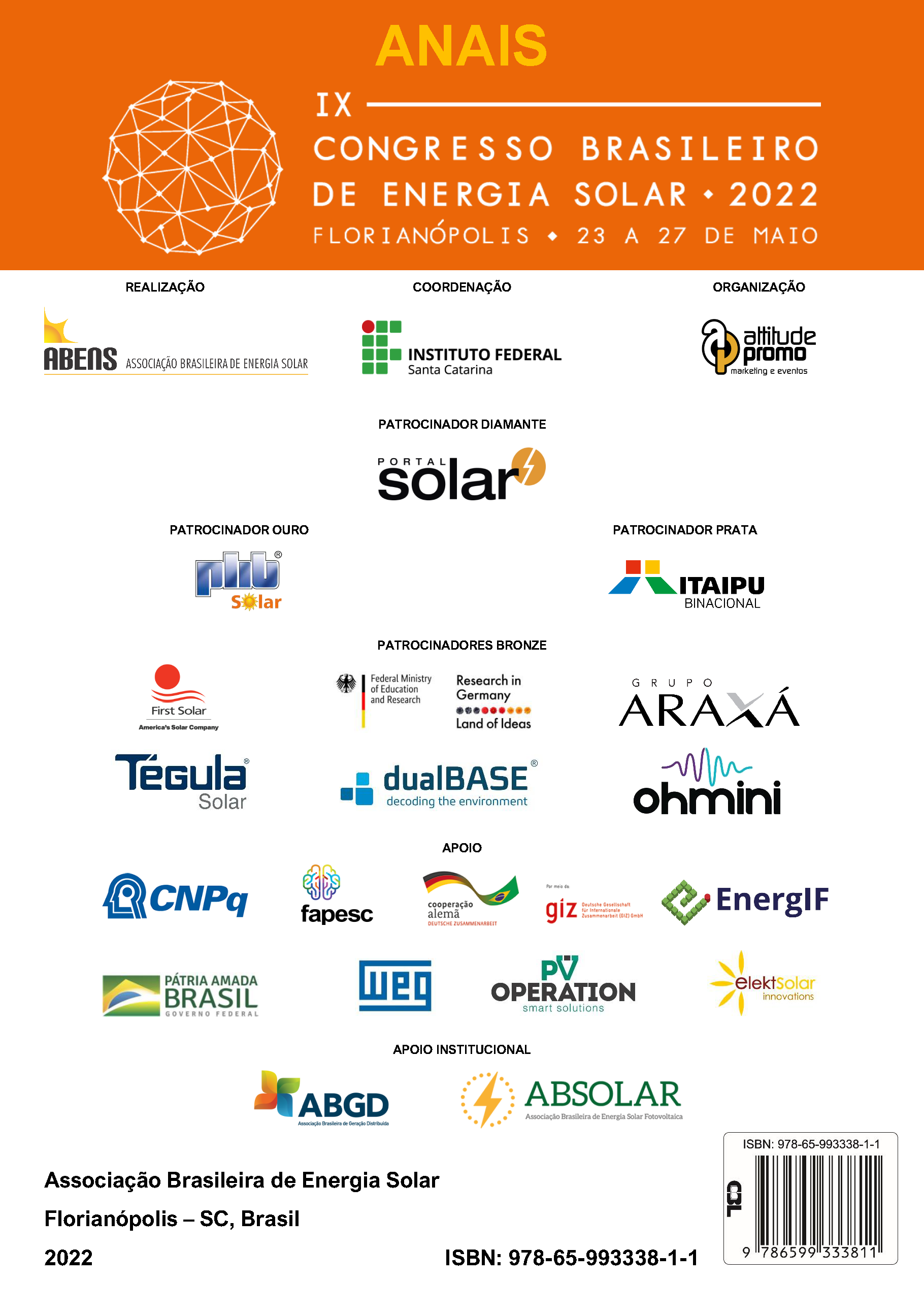PERFORMANCE ANALYSIS THROUGH THE PERFORMANCE RATIO OF PHOTOVOLTAIC PLANTS IN THE SAME LATITUDE
DOI:
https://doi.org/10.59627/cbens.2022.1169Keywords:
Solar Energy, Performance PV Systems, Performance RatioAbstract
With the exponential growth of photovoltaic systems (FV) worldwide, a performance analysis has become a significant tool to maximize the generated electricity. In the literature, the Performance Ratio (PR) is the most used indicator, as a contractual condition or guarantee in the commissioning of PV systems, as a way of evaluating the yield and as a global performance in the forecast of generation in PV plants that participate in auctions of electrical systems in the medium and short term. In this study, three plants FV were analysed, from January/21 to December/21, they are in Pesqueira-PE with characteristics of similar, two with modules with polycrystalline silicon technology and one with monocrystalline silicon technology, from different manufacturers and different power loss rate by temperature. The PR was calculated using the IEC 61724 and National Renewable Energy Laboratory (NREL) methods, which consider the conditions at the study site, adding the cell temperature to the equation. The minimum value of PR occurred in the month of January because is the month with highest annual ambient temperature; Regarding the highest PR, each plant presented a value and in different months, possibly due to the characteristics of each installation. The B plant with monocrystalline silicon technology modules presented PR small than the plants with polycrystalline silicon modules. In addition, the parameter showed no sensitivity to the operating time of the system, as the C plant with six years of use resulted in values of the PR like those with two years of activity. The value of PR is biggest in the colder months, because the temperature influence in the performance of PV systems.
Downloads
References
Cañete, C.; Carretero, J.; Sidrach-de-Cardona, M. Energy performance of different photovoltaic module technologies under outdoor conditions. Energy, v. 65, p. 295-302, 2014.
Chaves, A. S. Tecnologias de eletricidade limpa podem resolver a crise climática. Revista Brasileira de Ensino de Física. v. 43, 2021.
Dierauf, T. et al. Weather-corrected performance ratio. National Renewable Energy Lab. (NREL). United States, 2013.
Eke, R.; Demircan, H. Performance analysis of a multi crystalline Si photovoltaic module under Mugla climatic conditions in Turkey. Energy conversion and Management, v. 65, p. 580-586, 2013.
EPE, Empresa de Pesquisa Energética. Instruções para Solicitação de Cadastramento e Habilitação Técnica com vistas à participação nos Leilões de Energia Elétrica. Rio de Janeiro, 2021.
EPE, Empresa de Pesquisa Energética. Plano Nacional de Energia 2050. Brasília, 2020.
GOPI, A. et al. Comparison of normal and weather corrected performance ratio of photovoltaic solar plants in hot and cold climates. Energy for Sustainable Development, v. 65, p. 53-62, 2021.
IEC. International Standard IEC 61724: 1 - Photovoltaic System Performance - Part 1: Monitoring. 2021.
IRENA, International Renewable Energy Agency. Renewable energy statistics. Abu Dhabi, 2020.
Jordan, D. C.; Kurtz, S.R. Photovoltaic Degradation Rates-an Analytical Review, Progress in Photovoltaics: Research and Applications, vol. 21, n. 1, pp. 12-29, 2013.
Khalid, A. M. et al. Performance ratio–Crucial parameter for grid connected PV plants. Renewable and Sustainable Energy Reviews, v. 65, p. 1139-1158, 2016.
Kumar, B. S.; Sudhakar, K. Performance evaluation of 10 MW grid connected solar photovoltaic power plant in India. Energy reports, v. 1, p. 184-192, 2015.
Kumar, M.; Kumar, A. Performance assessment and degradation analysis of solar photovoltaic technologies: A review. Renewable and Sustainable Energy Reviews, v. 78, p. 554-587, 2017.
Kymakis, E.; Kalykakis, S.; Papazoglou, T. M. Performance analysis of a grid connected photovoltaic park on the island of Crete. Energy Conversion and Management, v. 50, n. 3, p. 433-438, 2009.
Leloux, J.; Narvarte, L.; Trebosc, D. Review of the performance of residential PV systems in France. Renewable and Sustainable Energy Reviews, v. 16, n. 2, p. 1369-1376, 2012.
Liu, B. Y.H.; Jordan, R. C. The long-term average performance of flat-plate solar-energy collectors: with design data for the US, its outlying possessions and Canada. Solar energy, v. 7, n. 2, p. 53-74, 1963.
Marion, B. et al. Performance parameters for grid-connected PV systems. In: Conference Record of the Thirty-first IEEE Photovoltaic Specialists Conference, 2005. IEEE, p. 1601-1606, 2005.
Micheli D.; Alessandrini S.; Radu R.; Casula I. Analysis of the outdoor performance and efficiency of two grid connected photovoltaic systems in northern Italy. Energy Convers Manag 2014; 80:436–45.
Oliveira, F. S. et al. Avaliação do Desempenho de Módulos Fotovoltaicos no Período Inicial de Operação. In: VII Congresso Brasileiro de Energia Solar-CBENS. 2020.
Pedrosa Filho M. H; Cavalcanti, E. B. Desenvolvimento de Mapa de Irradiação Solar Global para o Estado de Pernambuco. In: VII Congresso Brasileiro de Energia Solar-CBENS. 2020.
Rabl, A. Active solar collectors and their applications. Oxford University Press on Demand, 1985.
Reich, N. H. et al. Performance ratio revisited: is PR> 90% realistic? Progress in Photovoltaics: Research and Applications, v. 20, n. 6, p. 717-726, 2012.
Ross, R.G.; Smokler, M. I. Flat-Plate Solar Array Project Final Report, vol. VI, Engineering Sciences and Reliability. Report DOE/JPL-1012-125, 1986.
Satsangi, P. et al. Performance analysis of grid interactive solar photovoltaic plant in India. Energy for Sustainable Development, v. 47, p. 9-16, 2018.
Sharma, V.; Kumar, A.; Sastry, O.; Chandel, S. Performance assessment of different solar photovoltaic technologies under similar outdoor conditions. Energy, 58:511–8, 2013.
Silva, C. S. V. et al. Rastreador solar de eixo duplo: um estudo para a otimização da energia solar fotovoltaica no Brasil. 2021.
Skoplaki, E.; Palyvos, J. A. On the temperature dependence of photovoltaic module electrical performance: A review of efficiency/power correlations. Solar energy, v. 83, n. 5, p. 614-624, 2009.
Townsend, T. U.; Hutchinson, P. A. Soiling Analysis at PVUSA. Proceedings of ASES-2000, Madison, WI, 2000.
Ueda, Y. et al. Performance analysis of various system configurations on grid-connected residential PV systems. Solar energy materials and solar cells, v. 93, n. 6-7, p. 945-949, 2009.
Yamada, G. D. et al. Métricas de Cálculo de Eficiência na Produção de Energia em Plantas Fotovoltaicas. In: Congresso Brasileiro de Automática-CBA. 2020.


